Which of the following are parts of the circulatory system?
A) Heart
B) cerebral ventricle
C) artery
D) arteriole
E) capillary
F) bile duct
G) venule
H) vein
A) Heart
C) artery
D) arteriole
E) capillary
G) venule
H) vein
The _____ are the tiniest vessels in te circulatory system.
Capillaries
The capillaries are the tiniest vessels in te circulatory system.
In which of the following can Doppler ultrasound detect flow?
A) the heart
B) arteries
C) arterioles
D) capillaries
E) venule
F) veins
A) the heart
B) arteries
F) veins
To flow is to move in a _____.
stream
To flow is to move in a stream.
The characteristic of a fluid that offers resistance to flow is called _____.
A) resistance
B) viscosity
C) inertia
D) impedance
E) density
B) viscosity
The characteristic of a fluid that offers resistance to flow is called viscosity.
Poise is a unit of _____.
viscosity
Poise is a unit of viscosity.
Pressure is _____ per unit area.
force
Pressure is force per unit area.
Pressure is _____.
A) nondirectional
B) unidirectional
C) omnidirectional
D) all of the above
E) none of the above
C) omnidirectional
Pressure is omnidirectional.
Flow is a response to pressure _____ or _____.
difference, gradient
Flow is a response to pressure difference or gradient.
If the pressure is greater at on end of a liquid-filled tube or vessel than it is at the other, the liquid will flow from the _____-pressure end to the _____-pressure end.
A) higher, lower
B) lower, higher
C) depends on the liquid
D) all of the above
E) none of the above
A) higher, lower
If the pressure is greater at on end of a liquid-filled tube or vessel than it is at the other, the liquid will flow from the higher-pressure end to the lower-pressure end.
The volumetric flow rate in a tube is determined by _____ difference and _____.
The volumetric flow rate in a tube is determined by pressure difference and resistance.
pressure, resistance
Flow increases if _____ increases.
A) pressure difference
B) pressure gradient
C) resistance
D) A and B
E) all of the above
D) A and B
Flow increases if pressure difference and pressure gradient increase.
As flow resitance increases, volumetric flow rate _____.
decreases
As flow resitance increases, volumetric flow rate decreases.
If pressure difference is doubled, volumetric flow rate is _____.
A) unchanged
B) quartered
C) halved
D) doubled
E) quadrupled
D) doubled
If pressure difference is doubled, volumetric flow rate is doubled.
If flow resitance is doubled, volumetric flow rate is _____.
A) unchanged
B) quartered
C) halved
D) doubled
E) quadrupled
C) halved
If flow resitance is doubled, volumetric flow rate is halved.
Flow resitance in a vessel depends on _____.
A) vessel length
B) vessel radius
C) blood viscosity
D) all of the above
E) none of the above
D) all of the above
Flow resitance in a vessel depends on vessel length, vessel radius and blood viscosity.
Flow resitance decreases with an increase in _____.
A) vessel length
B) vessel radius
C) blood viscosity
D) all of the above
E) none of the above
B) vessel radius
Flow resitance decreases with an increase in vessel radius.
Flow resistance depends most strongly in _____.
A) vessel length
B) vessel radius
C) blood viscosity
D) all of the above
E) none of the above
B) vessel radius
Flow resistance depends most strongly in vessel radius.
Volumetric flow rate decreases with an increase in _____.
A) pressure difference
B) vessel radius
C) vessel length
D) blood viscosity
E) C and D
E) C and D
Volumetric flow rate decreases with an increase in vessel length and blood viscosity.
When the speed of a fluid is constant across a vessel, the flow is called _____ flow.
A) volume
B) parabolic
C) laminar
D) viscous
E) plug
E) plug
When the speed of a fluid is constant across a vessel, the flow is called plug flow.
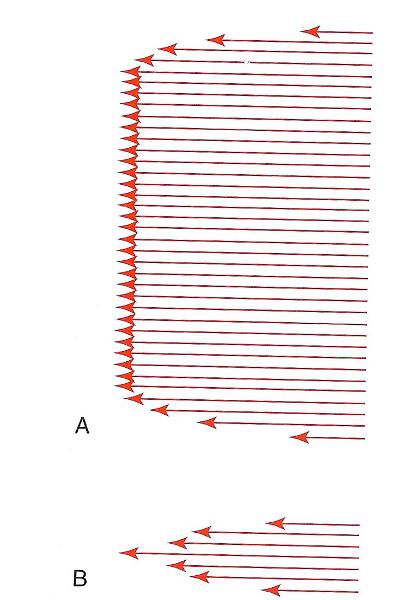
The type of flow (approximately) seen in A is _____.
A) volume
B) steady
C) parabolic
D) viscous
E) plug
E) plug
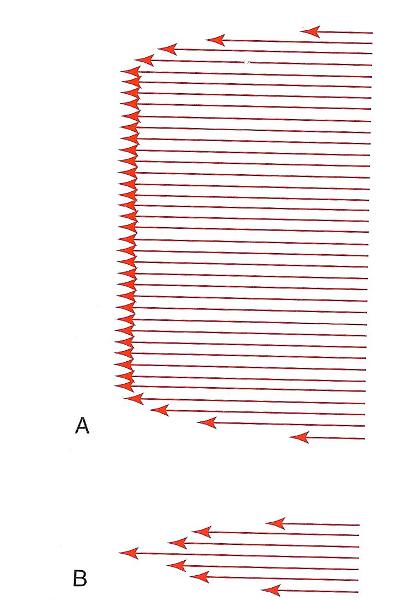
The type of flow seen in B is ____.
A) volume
B) steady
C) parabolic
D) viscous
E) plug
C) parabolic
_____ flow occurs when straight parallel streamlines describing the flow are altered.
disturbed
Disturbed flow occurs when straight parallel streamlines describing the flow are altered.
_____ flow involves random and chaotic flow patterns, with particles flowing in all directions.
turbulent
Turbulent flow involves random and chaotic flow patterns, with particles flowing in all directions.
Turbulent flow is more likely proximal of distal to a stenosis.
distal
Turbulent flow is more likely distal to a stenosis.
A narrowing of the lumen of a tube is called a _____.
stenosis
A narrowing of the lumen of a tube is called a stenosis.
Proximal to, at, and distal to a stenosis, _____ must be constant.
A) laminar flow
B) disturbed flow
C) turbulent flow
D) volumetric flow rate
E) none of the above
D) volumetric flow rate
Proximal to, at, and distal to a stenosis, volumetric flow rate must be constant.
Proximal to, at, and distal to a stenosis, _____ must be constant.
Flow speed at the stenosis must be _____ that proximal and distal to it.
A) greater than
B) less than
C) less turbulent than
D) less disturbed than
E) none of the above
A) greater than
Proximal to, at, and distal to a stenosis, greater than must be constant.
Poiseuille's equation predicts a _____ in flow speed with a decrease in vessel radius.
decreases
Poiseuille's equation predicts a decreases in flow speed with a decrease in vessel radius.
The continuity rule predicts a ____ in flow speed with a localized decrease in (stenosis) in vessel diameter.
increases
The continuity rule predicts a increases in flow speed with a localized decrease in (stenosis) in vessel diameter.
In a stenosis, the pressure is _____ the proximal and distal values.
A) less than
B) equal to
C) greater than
D) depends on the fluid
E) none of the above
A) less than
In a stenosis, the pressure is less than the proximal and distal values.
Added forward flow and flow reversal in diastole can occur with ____ flow.
A) volume
B) turbulent
C) laminar
D) disturbed
E) pulsatile
E) pulsatile
Added forward flow and flow reversal in diastole can occur with pulsatile flow.
As stenosis diameter decreases, _____ pass through a maximum.
A) flow speed at the stenosis
B) flow proximal to the stenosis
C) volumetric flow rate
D) the Doppler shift at the stenosis
E) A and D
E) A and D
As stenosis diameter decreases, flow speed at the stenosis and the Doppler shift at the stenosis passes through a maximum.
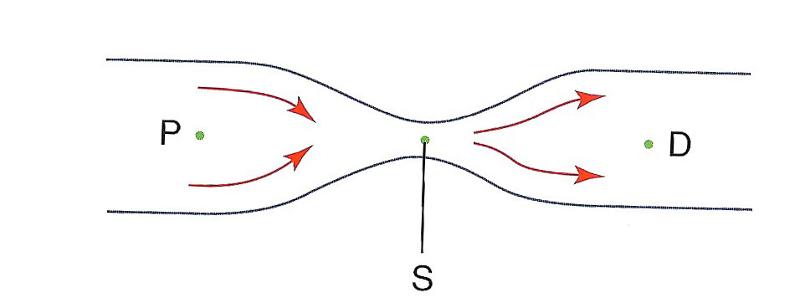
At which point is pressure the lowest?
A) P
B) S
C) D
D) P and D
E) none of the above
B) S
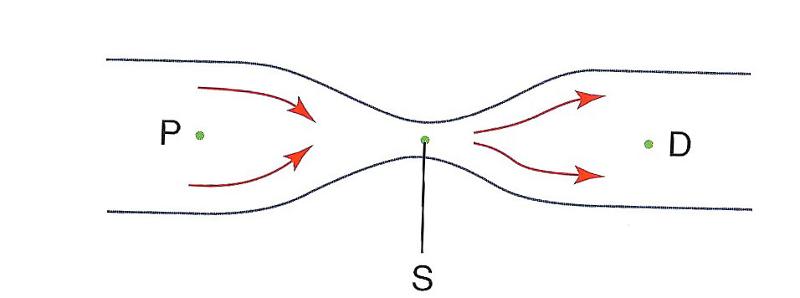
At which point is flow speed the lowest?
A) P
B) S
C) D
D) P and D
E) none of the above
D) P and D
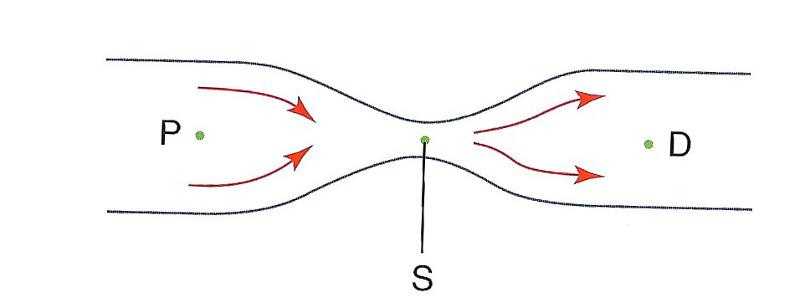
At which point is volumetric flow rate the lowest?
A) P
B) S
C) D
D) P and D
E) none of the above
E) none of the above
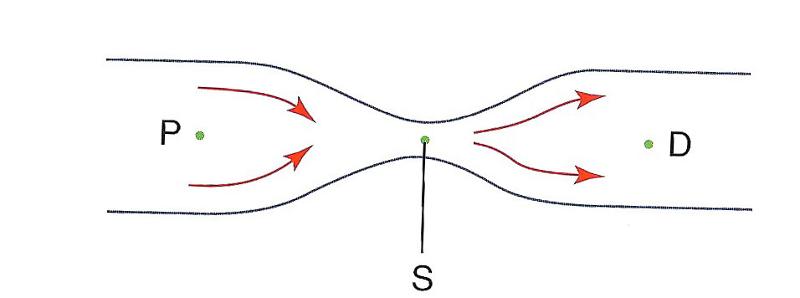
At which point is pressure energy the greatest?
A) P
B) S
C) D
D) P and D
E) none of the above
D) P and D
The _____ effect is used to detect and measure ____ in vessels.
Doppler, flow
The Doppler effect is used to detect and measure flow in vessels.
Motions of an echo-generating structure causes an echo to have a different ____ from that of the emitted pulse.
frequency
Motions of an echo-generating structure causes an echo to have a different frequency from that of the emitted pulse.
If the incident frequency is 1 MHz, the propagation speed is 1600 m/s and the reflector speed is 16 m/s toward the source, the Doppler shift is _____ MHz, and the reflected frequency is _____ MHz.
.02, 1.02
If the incident frequency is 1 MHz, the propagation speed is 1600 m/s and the reflector speed is 16 m/s toward the source, the Doppler shift is .02 MHz, and the reflected frequency is 1.02 MHz.
If 2-MHz ultrasound is reflected from a soft tissue boundary moving at 10 m/s toward the source, the Doppler shift is ____ MHz.
.026
If 2-MHz ultrasound is reflected from a soft tissue boundary moving at 10 m/s toward the source, the Doppler shift is .026 MHz.
If 2-MHz ultrasound is reflected from a soft tissue boundary moving at 10 m/s away from the source, the Doppler shift is ____ MHz.
-.026
If 2-MHz ultrasound is reflected from a soft tissue boundary moving at 10 m/s away from the source, the Doppler shift is -.026 MHz.
The Doppler shift is the difference between _____ and _____ frequencies.
received, emitted
The Doppler shift is the difference between received and emitted frequencies.
When incident sound direction and reflector motion are not parrallel, calculation of the reflected frequency involves the _____ of the angle between these directions.
cosine
When incident sound direction and reflector motion are not parrallel, calculation of the reflected frequency involves the cosine of the angle between these directions.
If the incident frequency is 1 MHz, the propagation speed is 1600 m/s and the reflector speed is 16 m/s toward the source, the Doppler shift is .02 MHz, and the reflected frequency is 1.02 MHz.
If the angle between incident sound direction and reflector motion is 60 degrees, the Doppler shift and reflected frequency are _____ MHz and _____ MHz.
If the incident frequency is 1 MHz, the propagation speed is 1600 m/s and the reflector speed is 16 m/s toward the source, the Doppler shift is .02 MHz, and the reflected frequency is 1.02 MHz.
If the angle between incident sound direction and reflector motion is 60 degrees, the Doppler shift and reflected frequency are .01 MHz and 1.01 MHz.
.01, 1.01 (The Doppler shift is cut in half)
If the incident frequency is 1 MHz, the propagation speed is 1600 m/s and the reflector speed is 16 m/s toward the source, the Doppler shift is .02 MHz, and the reflected frequency is 1.02 MHz.
If the angle between incident sound direction and reflector motion is 90 degrees, the cosine of the angle is _____, and the reflected frequency is _____ MHz.
If the incident frequency is 1 MHz, the propagation speed is 1600 m/s and the reflector speed is 16 m/s toward the source, the Doppler shift is .02 MHz, and the reflected frequency is 1.02 MHz.
If the angle between incident sound direction and reflector motion is 90 degrees, the cosine of the angle is 0, and the reflected frequency is 1.00 MHz.
0, 1.00 (no Doppler shift at 90 degrees)
For an operating frequency of 2 MHz, a flow speed of 10 cm/s and a Doppler angle of 0 degrees, calculate the Doppler shift.
.26 kHz
For an operating frequency of 6 MHz, a flow speed of 50 cm/s and a Doppler angle of 60 degrees, calculate the Doppler shift.
1.95 kHz
For blood flow through a vessel with a plug flow profile, the Doppler shift is _____ across the vessel.
For blood flow through a vessel with a plug flow profile, the Doppler shift is constant across the vessel.
constant
Which Doppler angle yields the greatest Doppler shift?
A) -90
B) -45
C) 0
D) 45
E) 90
C) 0
To proceed from a measurement of Doppler shift frequency to a calculation of flow speed, _____ _____ must be known of assumed.
To proceed from a measurement of Doppler shift frequency to a calculation of flow speed, Doppler angle must be known of assumed.
Doppler angle
If operating frequency is doubled, the Doppler shift is _____.
If operating frequency is doubled, the Doppler shift is doubled.
Doubled
If flow speed is doubled, the Doppler shift is _____.
Doubled
If flow speed is doubled, the Doppler shift is doubled.
If angle is doubled, the Doppler shift is _____.
decreased
If angle is doubled, the Doppler shift is decreased.
Color Doppler instruments presents two-dimensional, color-coded images representing _____ that are superimposed on gray-scale images representing _____.
motion, anatomy
Color Doppler instruments presents two-dimensional, color-coded images representing motion that are superimposed on gray-scale images representing anatomy.
Which of the following on a color Doppler display is (are) presented in real time?
A) gray-scale anatomy
B) flow direction
C) Doppler spectrum
D) A and B
E) all of the above
D) A and B
A) gray-scale anatomy
B) flow direction
Color Doppler instruments use an _____ technique to yield Doppler information in real time.
autocorrelation
Color Doppler instruments use an autocorrelation technique to yield Doppler information in real time.
Color Doppler instruments use an autocorrelation technique to yield Doppler information in real time.
This information includes _____ Doppler shift, _____, _____, and _____.
mean, sign, variance, power
Color Doppler instruments use an autocorrelation technique to yield Doppler information in real time.
This information includes mean Doppler shift, sign, variance, and power.
True or False?
The angle dependencies of Doppler shift displays and Doppler power displays are different.
True
Power displays have no angle dependence
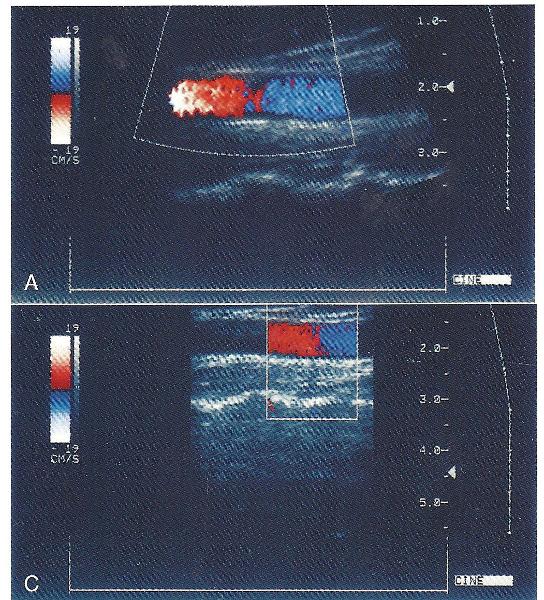
Do the different colors appearing in A and C indicate that flow is going in two different directions in the vessel?
Get image
no
True or False?
In color Doppler instruments, color is used only to represent flow direction.
False
In practice, approximately _____ pulses are required to obtain one line of color Doppler information.
A) 1
B) 10
C) 100
D) 1000
E) 1,000,000
B) 10
In practice, approximately 10 pulses are required to obtain one line of color Doppler information.
About _____ frames per second are produced by a color Doppler instrument.
A) 10
B) 20
C) 40
D) 80
E) more than one of the above
E) more than one of the above
A) 10
B) 20
C) 40
True or False?
Doppler shift displays are not dependent on Doppler andgle.
False
True or False?
If a color Doppler instrument shows two colors in the same vessel, it always means flow is occurring in opposite directions in the vessel.
False
It also can mean aliasing or changing Doppler
True or False?
A region of bright color on a Doppler shift display always indicates the highest flow speeds.
False
remember the Doppler angle
Increasing the ensemble length ____ the frame rate.
decreases
Increasing the ensemble length decreases the frame rate.
The _____ technique is commonly used to detect echo Doppler shifts in color Doppler instruments.
autocorrection
The autocorrection technique is commonly used to detect echo Doppler shifts in color Doppler instruments.
Which of the following reduce the frame rate of a color Doppler image?
A) wider color window
B) longer color window
C) increased ensemble length
D) Higher transducer frequency
E) Higher priority setting
A) wider color window
C) increased ensemble length
Lack of color in a vessel containing blood flow may be attributed to _____.
A) low color gain
B) a high wall filter setting
C) a low priority setting
D) baseline shift
E) aliasing
A) low color gain
B) a high wall filter setting
C) a low priority setting
Lack of color in a vessel containing blood flow may be attributed to low color gain, a high wall filter setting and a low priority setting.
Increasing ensemble length _____ color sensitivity and accuracy and _____ frame rate.
A) improves, increases
B) degrades, increases
C) degrades, decreases
D) improves, decreases
E) none of the above
D) improves, decreases
Increasing ensemble length improves color sensitivity and accuracy and decreases frame rate.
Which control can be used to help with clutter?
A) wall filter
B) gain
C) baseline shift
D) pulse repetition frequency
E) smoothing
A) wall filter
Color map baselines are always represented by ______.
A) white
B) black
C) red
D) blue
E) cyan
B) black
Color map baselines are always represented by black.
Doubling the width of a color window produces a ____ frame rate.
A) doubled
B) quadrupled
C) unchanged
D) halved
E) quartered.
D) halved
Doubling the width of a color window produces a halved frame rate.
Steering the color window to the right or left produces a _____ frame rate.
A) doubled
B) quadrupled
C) unchanged
D) halved
E) quartered.
C) unchanged
Steering the color window to the right or left produces a unchanged frame rate.
Autocorrelation produces _____.
A) the color of the Doppler shift
B) the mean value of the Doppler shift
C) varience
D) spectrum
E) peak Doppler shift
B) the mean value of the Doppler shift
C) varience
Autocorrelation produces the mean value of the Doppler shift and varience.
Steering the color window to the right or left changes _____.
A) frame rate
B) pulse repetition frequency
C) the Doppler angle
D) the Doppler shift
E) more than one of the above
E) more than one of the above
C) the Doppler angle
D) the Doppler shift
Color Doppler frame rates are _____ gray-scale rates.
A) equal to
B) less than
C) more than
D) depends on color map
E) depends on priority
B) less than
Color Doppler frame rates are less than gray-scale rates.
In a single frame, color can change in a vessel because of _____.
A) vessel curvature
B) sector format
C) helical flow
D) diastolic flow reversal
E) all of the above
E) all of the above
In a single frame, color can change in a vessel because of vessel curvature, sector format, helical flow and diastolic flow reversal.
True or False?
Angle is not important in transverse color Doppler views through vessels.
False
Compared with Doppler-shift imaging, Doppler-power imaging is _____.
A) more sensitive
B) angle independent
C) aliasing independent
D) speed independent
E) all of the above
E) all of the above
Compared with Doppler-shift imaging, Doppler-power imaging is more sensitive, angle independent, aliasing independent and speed independent
Doppler-power improving indicates (with color) the ____ of flow.
A) presense
B) direction
C) speed
D) character
E) more than on of the above
A) presense
Doppler-power improving indicates (with color) the presense of flow.
Doppler-shift improving indicates (with color) the ____ of flow.
A) presense
B) direction
C) speed
D) character
E) more than on of the above
E) more than on of the above
A) presense
B) direction
C) speed
D) character
The function of a Doppler detector include _____.
A) amplification
B) phased quadrature detection
C) Doppler shift detection
D) sign determination
E) all of the above
E) all of the above
The function of a Doppler detector include amplification, phased quadrature detection, Doppler shift detection and sign determination.
An earlier gate time means ____ sample volume depth.
A) a later
B) a shallower
C) a deeper
D) a stronger
E) none of the above
B) a shallower
An earlier gate time means a shallower sample volume depth.
Doppler signal power is proportional to _____.
A) volume flow rate
B) flow speed
C) the Doppler angle
D) cell concentration
E) More than one of the above
D) cell concentration
Doppler signal power is proportional to cell concentration.
True or False.
Doppler ultrasound provides information about flow conditions only at the site of measurment.
False
Stenosis affects ____.
A) peak systolic flow speed
B) end diastolic flow speed
C) spectral broadening
D) window
E) all of the above
E) all of the above
Stenosis affects peak systolic flow speed, end diastolic flow speed, spectral broadening and window
Spectral broadening is a _____ of the spectral trace.
A) vertical thickening
B) horizontal thickening
C) brightening
D) darkening
D) horizontal shift
A) vertical thickening
Spectral broadening is a vertical thickening of the spectral trace.
If all the cells in a vessel were moving at the same constant speed, the spectral trace would be a _____ line.
A) thin horizontal
B) thin vertical
C) thick horizontal
D) thick vertical
A) thin horizontal
If all the cells in a vessel were moving at the same constant speed, the spectral trace would be a thin horizontal line.
True or False?
Disturbed flow produces a narrower spectrum.
False
True or False?
Turbulent flow produces a narrower spectrum.
False
As stenosis progreses, which of the following increases?
A) lumen diameter
B) systolic Doppler shift
C) Diastolic Doppler shift
D) spectral broadening
E) more than one of the above
E) more than one of the above
B) systolic Doppler shift
C) Diastolic Doppler shift
D) spectral broadening
True or False?
Higher flow speed always produces a higher Doppler shift on a spectral display.
False
Remember the Doppler angle
Flow reversal in diasole indicates _____.
A) a stenosis
B) an aneurysm
C) high distal resistance
D) low distal resistance'
E) more than one of the above
C) high distal resistance
Flow reversal in diasole indicates high distal resistance.
Decrease distal resistance normall causes end diastolic flow to _____.
A) increase
B) decrease
C) be disturbed
D) become turbulent
E) more than one of the above
A) increase
Decrease distal resistance normall causes end diastolic flow to increase.
If angle correction is set at 60 degrees but should be zero degrees, the display indicates a flow speed of 100 cm/s. The correct flow speed is _____ cm/s.
A) 25
B) 50
C) 100
D) 200
E) 400
B) 50
If angle correction is set at 60 degrees but should be zero degrees, the display indicates a flow speed of 100 cm/s. The correct flow speed is 50 cm/s.
If angle correction is set at zero degrees but should be 60 degrees, the display indicates a flow speed of 100 cm/s. The correct flow speed is _____ cm/s.
A) 25
B) 50
C) 100
D) 200
E) 400
D) 200
If angle correction is set at zero degrees but should be 60 degrees, the display indicates a flow speed of 100 cm/s. The correct flow speed is 200 cm/s.
If a 5-kHz Doppler shift corresponds to 100 cm/s, then a 2.5-kHz shift corresponds to _____ cm/s.
50
If a 5-kHz Doppler shift corresponds to 100 cm/s, then a 2.5-kHz shift corresponds to 50 cm/s.
Which of the following is increased if Doppler angle is increased?
A) aliasing
B) Doppler shift
C) effect of angle error
D) B and C
E) None of the above
C) effect of angle error